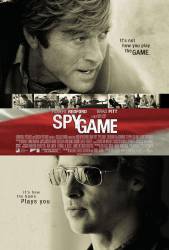Factual error: Redford's character speeds towards his office in Langley, Virginia driving his Porsche. As he passes a Georgian style building and the camera position, road markings (zig zag lines, metal road studs and a 'keep left' bollard) are all momentarily visible. This very short scene was obviously filmed on a UK road, certainly not in the US. (00:08:30)
Factual error: In the scene where you can see Robert Redford sending a fax, there is a Tux doll (Linux mascot) on the wall. Funny, but this scene happens in 1991 and Tux was first designed in 1996. (01:40:24)
Factual error: The hat that Brad Pitt wears in the 1985 scenes is a Padres hat with navy, orange and white as the colours. In 1985, the Padres' colors were brown and yellow. The color change didn't come until late 80's or early 90's.
Factual error: The "American Consulate in Hong Kong" is actually the HSBC building. The actual consulate building is nearby, but perhaps not so photogenic.
Factual error: In Suzhou Prison, presumably the Suzhou near Shanghai, all the prison guards are speaking Cantonese, which is a southern dialect. They should be speaking either Mandarin (Putonghua) or their regional dialect.
Factual error: In the scene where Brad Pitt meets Robert Redford on the roof of a house in Berlin in (I think it was) 1980, you can see a lot of GSM transmitters. GSM cell transmitters didn't come until 1993.
Factual error: At the end of the movie it is about 7:42am in Langley, Virginia. In Suzhou, Tom Bishop is being rescued out of the prison and as he is being flown away you see sunlight poking down through the clouds in the backdrop. It would be 8:42pm there. Since they showed the Berlin wall falling on the news that would put the film at the beginning of November in 1989 where it would be dark at 9pm.
Factual error: Satellite photos on Robert Redford's desk depict Suzhou as lying on the coast of China. In fact it is far inland.
Factual error: There would never be a US Embassy in Hong Kong - only a consulate.
Factual error: Bishop is drinking out of a cafe in Beirut, just in front of Elizabeth's hotel. There is a Coca Cola logo on the tend, but this logo will appear only in the '90s.
Factual error: Part of the movie is set in Beirut during 1985. Periodically, there are scenes with Robert Redford's character working from a command post in the American Embassy. Behind him, is a quite modern looking 15" monitor. The interesting part is that although the monitor looks out of place, the makers of the movie saw fit to fill the screen with monochromatic "green" information, which would be consistent with 1985.
Factual error: Robert Redford's call to the London Stock Exchange to liquidate and transfer his holdings to the Caymen Islands makes no sense. The LSE does not provide that kind of service, it is a regulatory body which admits companies to the Exchange and regulates them. In reality he would have called a bank or stockbroker to execute this type of transaction. And that banker or broker would not have been sitting in the LSE building on Old Broad Street in the City of London. There is no physical trading floor at the LSE, in the way which is depicted in the film, for the banker or broker to work from.
Factual error: The part of the film set in the CIA Headquarters is suppose to take place in 1991. However, Robert Redford's character seems to have both a cell phone and a two-way pager that are quite advanced for the early 1990s. Not to mention the fact that cell phones aren't allowed in places like the CIA headquarters, because they aren't secure and they might allow people to eavesdrop on classified conversations.
Factual error: One of the scenes in the movie shows a lovely green bridge in "West Germany". Too bad this bridge actually is the Szabadság Bridge in Budapest, Hungary.
Factual error: In the opening Redford crosses the Arlington Memorial Bridge into DC while driving to the CIA. The CIA is not in DC; it's in Virginia and you would never cross that bridge to get there.
Factual error: When Brad Pitt and Catherine McCormack are in a cafe in Beirut in the 80s, the song in the background is a song released in the year 2000 by the Lebanese singer Pascale Machaalani.
Factual error: The Chinese ambulance Tom uses to escape prison when presumed dead reads 'ambulance' on the side in English instead of Chinese.
Factual error: When Bishop sees Nathan at the train station, his hair is too long for a Marine.






Chosen answer: He might have taken a medical equivalent to a regulated dose of Curare, which can suspend the body temporarily in a coma-like state, while keeping the mind active and perceptive. It could also have been tetrodotoxin, which has remarkably similar effects, but lasts longer. In either case, they were specifically engineered for his physiology, indicating a pharmacologist's aid in their endeavor.